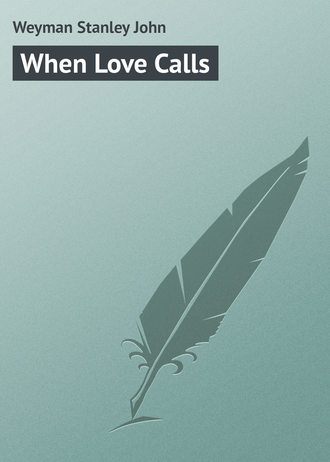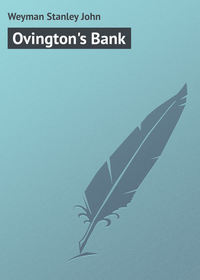 полная версия
полная версияWhen Love Calls
About mid-day we passed over the last ridge of the uplands, and saw below us a narrow fertile valley squeezed in between mountain-walls. Halfway through this gorge and in the middle of it, a hill or rock rose abruptly almost to the height of a thousand feet. On this, lording it over the road, stood Caylus, its houses and gardens descending terrace by terrace from the castle-nucleus on the crest almost to the road. Very old was the church, about the porch of which are carved green animals in the act of nibbling one another's tails under the superintendence of St. Michael. We took it for St. Michael. Old, too, seemed the great stone house opposite, known as the Maison du Loup, and bearing uncouth masks and figures of wolves in high relief on its front. Older still we judged the market-place to be, which built of wood rests on stone pillars; and the heavy Arcade or "Row" which stands in the same tiny square with it, and the beetle-browed wynds that lead to it-all old, gray, heavy, time-stained, but still solid. In the market hall we noticed three ancient corn-measures; hollows scooped out in stones that formed part of the fabric of the hall, with to each a horizontal outlet or spout at the side, through which the grain when measured might escape into bag or basket. Even while we were examining these we remarked women sitting outside the doors about us, removing the grain from stalks of maize, and plaiting various articles with the straw.
The weather-beaten castle belongs to Madame St. Cyr, but was occupied when we visited it by Mr. Wilton, an Englishman, who was not at home. His housekeeper, however, kindly allowed us to go over the building, and we found the view from the leads of the keep-used, I suspect, as a smoking-room-very charming. Caylus, to sum up, is difficult of access and is not even named in "Murray," but I can highly recommend it as a quaint example of a mediæval town, such as cannot now be found in England without much searching.
From it we passed by means of a top-heavy, jingling country coach to St. Anthonin, and so by rail to Albi on the Tarn, Albi of the Albigenses, the unhappy sect whose fate confutes the saying that the blood of martyrs is the seed of the church. About Albi, from which place they took their name, they grew and flourished in the latter half of the twelfth century. But seventy years later, notwithstanding the attempt which their feudal lord, Raymond of Toulouse, made to protect them, they were virtually extinct. Save that they dissented from the Romish Church, their very doctrines are now unknown or to be found only in the writings of their enemies, and their story and fortunes are too often confounded with those of the Waldenses. Simon de Montfort, the father of our Simon de Montfort, took a conspicuous part in the cruel deeds which attended their suppression. At the fall of Beziers, heretic and churchman were put to the sword together. "Slay all-God will know His own," said the gentle Abbot Arnold. And in a sense wisely: for it is only the man of half measures who fails as a persecutor. To be perfectly ruthless, perfectly thorough in the work, is to be successful also. At any rate at Albi, which, like Cahors, stands among hills, there are no traces of the Albigenses left; not even such a story as rings about the name of Beziers with fire. Rather the great cathedral proclaims Rome's victory. Built externally of bricks, it is a huge blind oblong with an apsidal end. A swelling base and rounded buttresses add to its heavy appearance. Yet it is very lofty. The monstrous red tower hung about with giddy balconies rises nearly to the height of three hundred feet, while the church itself, the lower part of which has no openings or windows, seems half that height. In a word, the whole is as much a fortress as a cathedral. Lofty flights of steps lead to a raised porch, formed by three arches decorated with carvings lately and successfully restored. Entering the church through this we find the interior a striking sight. In shape it is a vast hall surrounded by chapels in two stories, and with a choir screened off at one end. The interior still remains in the state to which our Puritans objected, the state probably characterized more churches than we now imagine. It is covered from ceiling to floor with frescoes and paintings and scrollwork, some gaudy, some subdued, some good, some bad. The very statues are painted and gilded, and although here and there the effect is garish and unpleasing, I do not agree that the appearance of the whole, as the vast mass of color presents itself to the eyes, broken by the exquisite carvings of the stone screen or a bevy of tinted marbles, is absolutely unharmonious. I found it more pleasing than I expected. And then what would have been the effect of these plain walls in their naked monotony?
The paintings are mainly of the date of Francis I., say about 1520. Two frescoes of Hell and the Passions, done by Italian artists, cover the west end-cover acres of it as it seems; and in a chapel, among other anachronisms is a notable picture of Christ, in which He is figured in a hat and feather and the dress of a courtier of the time in the midst of Roman soldiers who are kicking Him along. A great store of information as to the dresses and customs of the early part of the sixteenth century is laid up here, to be ransacked by any one who will take the trouble to closely inspect this huge interior. The groups painted upon the walls, groups of people fighting, tourneying, feasting, dancing, dying-ay, and doing many things scarcely adapted to church decoration-are to be counted by thousands; as are the gold stars that stud the bright blue ceiling. There is something suggestive in the portrayal of these things in this place; they seem to tell of a faith which, with all its scandals, abuses, and laxity, was bound up intimately with the life of the people, with their joys as well as their griefs; and so smacked of One who did not consider the price of sparrows as beneath knowledge.
At any rate we were pleased with these things. The interior of Albi Cathedral may not be in the best taste. It may be meretricious, it may be gilt rather than of gold. But it is curious; it is almost unique; it is a museum in itself; and to an Englishman accustomed to the cold if correct lines of a Gothic church, its warmth and color afford a not unwelcome change.
At Auch we arrived at night, and found it to be an old-fashioned archiepiscopal city on the summit and southern slope of a precipitous hill. Here we came upon the first traces-a Spanish pedler, a Navarrese bonnet-of that strange borderland between Spain and Western France in which three languages and a dozen patois, French, Spanish, Basque, the Langue d'Oc, the Langue d'Or, and Gascon and Provençal and the tongue of Andorra, and I know not what others, are fighting for the mastery: where two great nations now peaceably march, dividing between them the wild country where the kingdom of Navarre once sat enthroned on hills with the free Basque communities about her. It is a country rich in memories of independence, of strife; of brigandage, of romance; of the free life of the hunter; a land of snow-clad peaks and deep valleys, and rolling, wooded hills full of creatures elsewhere extinct, bears, and izards, and, shall I add, Basques. Here are Roncesvalles and the Bidassoa, Fontarabia and Orthez, San Sebastian and the Isle of Peacocks. Moor and Paladin, Scot and Spaniard, Charlemagne and Wellington, have all passed this way and left deep foot-prints.
And Auch stands on the verge of this strange country; an old city, but full of energy and with no trace of decay. From the river, flights of wide steps with spacious landings, gay with flowers and fountains, climb the southern face of the hill, which the best road-maker would find impracticable. At the head of these steps and commanding extensive prospects stands the cathedral, a beacon to all the country between it and the skirts of the mountains. The building is fine, but its pride lies in the wood carvings of the unrivalled choir. My guide, an ex-soldier, also pointed out with pride some cymbals presented to the cathedral by the first Napoleon: trophies, so he told me, of the Egyptian campaign.
We wandered out in the afternoon to the brow of a ridge of hills lying on the far side of the river, and throwing ourselves down upon some heather and bracken-it was a warm and sunny but not very clear day-began to cast speculative glances towards Spain. But while we thought that we were looking southwards our eyes were really turned too much to the east. And presently we discovered this in a strange way. For glancing by chance towards the skyline on our right, we saw, first, a brown autumnal landscape of woods and hills, and beyond this a long, gray cloud, the horizon, as we thought; and above that-ah! what was it we saw above that? A line of silvery peaks, gleaming in a gray, sheeny atmosphere of their own, so pure, so soft, so far above this world of ours, that as the words "The Pyrenees!" broke the first moments of astonished silence, we felt that for once the thing long looked for had passed our expectations! Our hearts fastened upon the distance. The pleasant landscape spread out before us lost its charms. It was homely, it was flat, it was commonplace, it was of the earth earthy, beside the serene beauty of the snowy crests and untrodden wastes that shone and sparkled in that far distance, and anon grew cold and dim as the veil of cloud was drawn before them even while we watched.
When they were gone, we felt that nothing save the mountains would now satisfy us. We had a craving for them, such as I have sometimes felt for the sea. A sudden conviction that we were wasting our time in a world of small things, while the wonders of the hills lay close at hand, overwhelmed us. We hurried homewards, talking of peaks, and glaciers, and passes, of Cauteret and Gavarnie, Mont Perdu and the Pic du Midi; and packed in the same state of pleasant excitement. The next morning saw us passing through the same country, rich in autumn tints, in leafy bottoms, and rippling streams, which we had seen stretched out before us. And the evening saw us stand on the famous Place Royale, hard by the castle where Henry of Navarre was born, feasting our eyes on the cold, bright tints of the great mountains, seen sharp and clear above the Jurance hills, and listening to the rushing waters of the Gave. Our Garonne pilgrimage was over.











